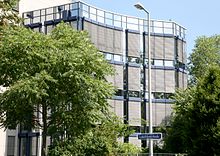Mannheim Medical Faculty
| Mannheim Medical Faculty | |
|---|---|
|
|
|
| founding | 1964 |
| place | Mannheim |
| state | Baden-Württemberg |
| country | Germany |
| dean | Sergij Goerdt |
| Students | 1600 |
| Website | www.umm.uni-heidelberg.de |
The Mannheim Medical Faculty is one of two independent medical faculties of the Ruprecht-Karls-Universität Heidelberg . Together with the Mannheim University Hospital , it forms the University Medical Center in Mannheim . Almost 1,600 students are currently enrolled in the faculty and around 60 professors are teaching. The faculty's buildings are concentrated on the premises of the University Clinic on Theodor-Kutzer-Ufer and in the nearby Ludolf-Krehl-Straße.
The MaReCuM model course (Mannheim Reformed Curriculum for Medicine and Medical-Related Professions) is divided into individual teaching and learning modules that break through the traditional subject boundaries. During their training, students can set priorities in order to gain qualifications in various directions. This tendency-oriented course of study is unique in Germany.
history
Already at the end of the 1950s it became apparent that the capacity of the Heidelberg Faculty of Medicine was reaching its limits, especially in the clinical study phase. To relieve the burden, the Mannheim Faculty was founded on November 5, 1964 as a legally dependent sub-faculty under the patronage of the Heidelberg Medical Faculty as "Section D".
On December 17, 1969, the Faculty of Clinical Medicine Mannheim was formed as the fifth Faculty of Medicine at the University of Heidelberg - alongside the four faculties that made up the Heidelberg Faculty of Medicine. In accordance with the basic rules of the university, it has since been a fully equal and independent faculty in the academic committees of Heidelberg University, with its own right to award doctorates and habilitation.
From 1964 to 2006, the Mannheim Faculty of Clinical Medicine trained medical students at the Mannheim University Hospital (until 1998, Mannheim City Hospital) exclusively in the clinical part of their studies after they had completed their pre-clinical training in Heidelberg. In the 2006/2007 winter semester, the faculty achieved the status of a full faculty with the establishment of the innovative MaReCuM model course and the associated establishment of a preclinical facility. Since then, the Mannheim Medical Faculty of the University of Heidelberg has been the fifth full medical faculty in the state of Baden-Württemberg.
Mannheim reformed curriculum for medicine and medical-related professions
Every year around 240 applicants are admitted to study human medicine in Mannheim. The Mannheim Medical Faculty has a total of around 1,600 students.
Classic subject boundaries are broken through in the undergraduate and graduate courses, with the focus being on topics, organs and diseases. This corresponds to the close interlinking of pre-clinical and clinical-theoretical science, basic research and teaching at the CBTM, which was created especially for MaReCuM. MaReCuM offers the opportunity to set qualification priorities during the training. For example, with electives with a focus on clinical-practical and research-oriented training taking health economic aspects into account, supplemented by the pre-clinical elective program tailored to this.
The division into four sections enables greater inclination orientation in the design of the practical year. The fourth quarter is carried out nationwide within MaReCuM as an outpatient quarter in university outpatient departments and in cooperation with teaching practices. MaReCum conveys specific and well-founded medical skills and competencies. This includes the ability to recognize and solve medical challenges, communication with colleagues and patients as well as the professional foundation for lifelong development as a doctor.
MaReCuM is one of the pioneers for more science in medical studies, for example with the Junior Scientific Masterclass or research work. A working group develops concepts as to how scientific work can be anchored in the entire course of studies.
The two master’s courses in Biomedical Engineering and Translational Medical Research complement the range of courses offered by the Mannheim Faculty of Medicine. The master’s degree programs are internationally oriented, are taught in English and lead to a Master of Science (MSc.) Degree.
research
The Medical Faculty Mannheim has four main research areas: medical technology, vascular biology and medicine, oncology and translational neurosciences. In the coming years, the faculty in the FSP is to be further developed, particularly with regard to "living with illness" and in particular the research and treatment of chronic cancer.
Center for Biomedicine and Medical Technology Mannheim (CBTM)
As the first medical faculty in Germany, the Mannheim faculty with the Center for Biomedicine and Medical Technology Mannheim (CBTM) combines the classic pre-clinical disciplines of anatomy, biochemistry and physiology together with endowed professorships and co-opted clinic-associated working groups in an overarching interdisciplinary research center.
University Medicine Mannheim
The University Medical Center Mannheim (UMM) consists of the municipal University Hospital Mannheim in association with the Medical Faculty Mannheim of the University of Heidelberg. The cooperation was newly regulated in the framework agreement between the state of Baden-Württemberg, the city of Mannheim, the University of Heidelberg and the University Hospital Mannheim from July 2015.
In the joint management committee, the so-called administrative board, the faculty and university hospital work together on an equal footing. Research and teaching are laid down as corporate goals of the University Medical Center Mannheim. In addition, it is stipulated that the university hospital is managed by two managing directors with equal rights, one of whom must be medically and scientifically qualified.
Web links
Individual evidence
- ↑ a b Success with innovations. (pdf) Annual report 2015. In: w2.umm.de. Mannheim University Medical Center, archived from the original on April 4, 2017 ; Retrieved April 3, 2017 .
- ^ History of the Medical Faculty Mannheim. Retrieved April 3, 2017 .
- ↑ Axel W. Bauer: 50 years ago: How medical studies began in Mannheim *. Retrieved April 3, 2017 .



